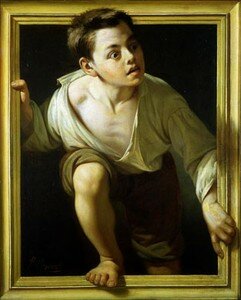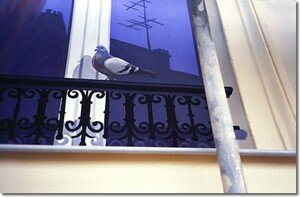My job
Escaping Criticism by My works, more pictures in portfolio deco.
Pere Borrell del Caso (1874).
Trompe-l'œil is an art technique involving extremely realistic imagery in order to create the optical illusion that the depicted objects really exist, instead of actually being a two-dimensional painting. The name is derived from French for "trick the eye", from tromper - to deceive and l'œil - the eye.
A trompe-l'œil of a pigeon on a window sill, façade mural, rue Emile Lepeu in Paris, France. Sotto in su, meaning From below, upward in Italian, (also called di sotto in su) is a term for a type of trompe l'œil illusionism used in ceiling paintings to suggest receding perspectives. The elements above the viewer are rendered as if viewed from true vanishing point perspective. This technique was frequently employed in Italian frescoed ceiling paintings, particularly 17th-century Baroque works, in the style called Quadratura. Probably its first use was by Andrea Mantegna in the Camera degli Sposi in Mantua. Other notable examples are Antonio da Correggio's Assumption of the Virgin in the Duomo of Parma; Pietro da Cortona's Allegory of Divine Providence in the Palazzo Barberini; and Andrea Pozzo's Apotheosis of St Ignatius on the ceiling of the Roman church of Sant'Ignazio. The interiors of Jesuit churches in the 16th and 17th-century mannerist and Baroque styles often include such trompe-l'œil ceiling paintings, which optically "open" the ceiling or dome to the heavens with a depiction of Jesus', Mary's, or a saint's ascension or assumption. Although the phrase has its origin in the Baroque period, when it refers to perspectival illusionism, use of trompe-l'œil dates back much further. It was (and is) often employed in murals. Instances from Greek and Roman times are known, for instance in Pompeii. A typical trompe-l'œil mural might depict a window, door, or hallway, intended to suggest a larger room. A version of an oft-told ancient Greek story concerns a contest between two renowned painters. Zeuxis produced a still life painting so convincing that birds flew down from the sky to peck at the painted grapes. He then asked his opponent, Parrhasius, to pull back a pair of very tattered curtains, believing the painting was behind them. Parrhasius won the contest, as his painting was the curtains themselves. With the superior understanding of perspective drawing achieved in the Renaissance, painters, beginning with Vittorio Carpaccio and Jacopo de' Barbari, often added trompe-l'œil features to their paintings, playfully exploring the boundary between image and reality. For example, a fly might appear to be sitting on the painting's frame, a curtain might appear to partly conceal the painting, a piece of paper might appear to be attached to a board, or a person might appear to be climbing out of the painting altogether. A Bachelor's Drawer by John Haberle (1890–94) Trompe-l'œil can also be found painted on tables and other items of furniture, on which, for example, a deck of playing cards might appear to be sitting on the table. A particularly impressive example can be seen at Chatsworth House in Derbyshire, where one of the internal doors appears to have a violin and bow suspended from it, in a trompe l'œil painted around 1723 by Jan van der Vaart. The American 19th century still-life painter William Harnett specialized in trompe-l'œil. In the 20th century, from the 1960s on, the American Richard Haas and many others painted large trompe-l'œil murals on the sides of city buildings, and trompe-l'œil became increasingly popular for interior murals. Erick Vittorino original mural Trompe-l'œil is employed in Donald O'Connor's famous "Running up the wall" scene in the film Singin' in the Rain. During the finale of his "Make 'em Laugh" number he first runs up a real wall. Then he runs towards what appears to be a hallway, but when he runs up this as well we realize that it is a large trompe-l'œil mural. Another variant of trompe-l'œil is matte painting, a technique used in filmmaking where parts of a complicated scenery are painted on glass panels which are mounted in front of the camera during shooting of the scene. This was for instance used in early Star Wars movies. Fictional trompe-l'œil is featured in many Looney Tunes, such as the Road Runner cartoons, where Wile E. Coyote (for example) paints a tunnel on a rock wall, and the road runner then races through the fake tunnel. This is usually followed by the coyote's foolishly trying to run through the tunnel after the road runner, only to smash into the hard rock-face. This also occurred in Who Framed Roger Rabbit. On Chicago’s Near North Side, a 16-story 1929 apartment hotel converted into a 1981 apartment building, was used by Richard Haas for trompe-l'œil murals in homage to Chicago School architecture. One of the building's sides features the Chicago Board of Trade Building, intended as a reflection of the actual building two miles south. George Washington was once fooled by a trompe-l'œil painting when he visited the studio of Charles Willson Peale. Upon entering a room containing on its far wall such a painting of someone descending a stair (apparently into the room), he is said to have bowed to the figure before he realized it was a painting. The painting, Staircase Group showed two of Peale's sons. A trompe- l'oeil in Lyon, France.Sotto in su
History in painting
In other artforms
Trivia









![Resident Evil : Degeneration - Trailer [VO]](https://image.canalblog.com/MWwOngJgJdjMrgFUJgJeqqbl1wE=/400x260/smart/filters:no_upscale()/https%3A%2F%2Fassets.over-blog.com%2Ft%2Fcedistic%2Fcamera.png)
/https%3A%2F%2Fstorage.canalblog.com%2F37%2F82%2F381415%2F20815251_o.jpg)
/https%3A%2F%2Fstorage.canalblog.com%2F57%2F88%2F381415%2F21720693_o.jpg)
/https%3A%2F%2Fstorage.canalblog.com%2F65%2F35%2F381415%2F19562151_o.jpg)
/https%3A%2F%2Fstorage.canalblog.com%2F08%2F08%2F381415%2F19042209_o.jpg)
/https%3A%2F%2Fstorage.canalblog.com%2F86%2F94%2F381415%2F19038541_o.jpg)
/https%3A%2F%2Fstorage.canalblog.com%2F09%2F70%2F381415%2F19038067_o.jpg)
/https%3A%2F%2Fprofilepics.canalblog.com%2Fprofilepics%2F3%2F2%2F328227.jpg)